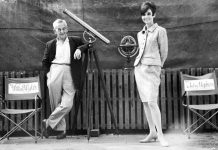Hopefully you haven’t gotten bored yet with the initial hype of making a movie and you now have a script on your lap. You’ve shown it to your friends and parents and they think it’s worthy of a lead role by Mr Cruise. But you’re not out of the woods yet! Now comes the hardest part, the part that all production companies hate doing: The Pre-Production!
The word pre-production means exactly that – it’s all your arrangements you need to make before you can grab a camera and head out to the set (or your garage). The first thing you need to do is a Script Breakdown. This is where you go through your script, scene by scene, and make a list of all the things you will need. The golden rule in film making is that nothing should be taken for granted. When you watch a movie it is important to note that nothing is shot by accident. Every vase, every person in the background (“extra”) and every item of clothing has been carefully selected by the director and his team.
Now that you have your Script Breakdown, you are going to acquire all the items on your list. Have you got an actor? How much will they charge you? Have you decided on all your locations? Do you have permission from the property owners to film there? Does the property have enough power outlets? Do you have a camera, cameraman, tapes, batteries and audio equipment? What is your cast and crew going to eat? Does your actor have the required props? All these questions need answers and confirmation on paper – should your film be magically picked up by an independent studio, you don’t want actors demanding 50% of all revenue. Get it in writing!

Next, you are going to do a Storyboard. This is basically a comic strip of your movie. It doesn’t have to be a Gieger sketch, just a basic sketch of each shot you will need. Many directors skip this step and hope that their inspiration will carry them through the day, but few directors can pull this off and you will have an entire cast and crew waiting for you to decide on the best angle. This also help you to cross out all the shots that you’ve got to prevent the crew going through a bunch of sketches trying to remember what else they need to film. There are a few basic guidelines to your shots:
- “Low Angle” (camera pointing up at the actor) makes the character look powerful.”High Angle” (camera pointing down at the actor) makes the character look weak.
- The closer you are to a characters face, the more personal/emotional the scene is.
- Start with a wide shot of the location (to show your audience where they are) and move in shot by shot.
- “Locked off” shots (camera on a tripod) translates as a controled scene.”Hand held” shots (shaky camera) translates as chaos, it also gives an urgent mood to a scene.
- The biggest object in the shot is the most important to that scene.
- Focus on your background as much as your foreground – a background with lots of depth (like a hallway) will look a lot better on camera than a flat, white wall.
- When you have the typical “tick-tock” shots of two characters talking, make sure that their eyes are looking in the right direction. This is what is called “eye line”.
- Headroom – leave a little bit of space between the characters head and the top of the frame.
- Nose room – if the character is moving right on screen, frame him one third from screen left. This draws the attention to what he moving towards.
- It is very important for young filmmakers not to get too cocky with their shots. A complicated shot just for the sake of complication screams of a director going “look at me!”, this also draws your audience’s attention away from the storyline. For a good reference, look at the break-in scene of Panic Room. David Fincher has staged a breathtakingly complicated shot while holding the audience fixed on the story.
Assuming that you don’t have budget for lighting, like most independent filmmakers, you will be shooting during the day. Avoid filming at noon as the sun is directly above your actors and the shot will look “flat”. The best time to film is what is known as “golden hour”- this is that magic hour of the day when the sun has just risen or before the sun sets. The sun will hit your actors from the side and make for a beautiful shot. Also make sure that the light hits your actors’ faces, especially the eyes. If the audience can’t see a person’s eyes, they loose empathy.

Once you have all your ducks in a row, you are going to contact your cast and crew and send them a “Call sheet”. This is a basic program for the day letting everyone know what time they need to be on set. Make sure that an actor who is only needed at 16h00, is asked to arrive at 08h00. But also make sure that an actor has enough time before his scene to prepare.
Now that you have everything you need to make sure that the shoot runs smoothly, have a cup of coffee, embrace the butterflies and get a good night’s rest – now the fun part starts!





